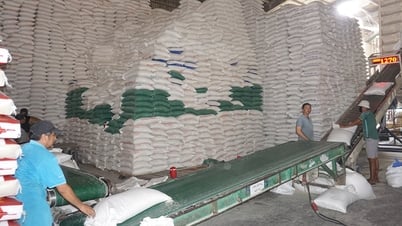Fearing the “avalanche” effect, many real estate businesses have asked banks to “open their purses” or lower lending standards to rescue the market. However, banks also have their own reasons for “tactfully” refusing to deal with such a specific situation. Meanwhile, fundamental solutions to adjust the real estate market to a sustainable trajectory all require time.
 Real estate businesses worry that a “frozen” market will have a chain reaction impact on the economy . Illustration photo: L.Vu. |
Real estate businesses need temporary solutions
Nearly the first two months of 2023 have passed, but the real estate market has not yet seen any positive signals from management policies affecting business activities. Meanwhile, maturing debts, rising interest rates, and weak liquidity are putting businesses in a dangerous state.
There have been many recommendations to rescue the real estate market and the bond market to prevent the avalanche effect from spreading from the real estate market to the banking system and many other business sectors.
After the recent meeting with the State Bank of Vietnam (SBV), there is still no clear message on whether or not to rescue the real estate market. All hopes of real estate businesses are waiting for the meeting chaired by the Government on February 17. Before this meeting, many large real estate businesses have also made recommendations on difficulties and wished to be supported with temporary solutions to overcome the immediate pressure.
In a previous document sent to the State Bank, Ms. Do Thi Phuong Lan, in charge of consulting on restructuring projects for No Va Real Estate Investment Group ( Novaland ), said that the company is continuing to work with commercial banks to resolve difficulties with domestic debts. As for foreign debts, Novaland has convinced partners to see this as a market risk in order to proceed with restructuring.
Therefore, this enterprise proposed that the State Bank consider allowing real estate corporations to restructure their debts and extend their debt repayments for 24-36 months. In addition, it requested that the State Bank, in its role as a leader of credit institutions, financial institutions, and commercial banks as professional investors, consider solutions that can help enterprises fulfill their obligations to bondholders.
Sharing the same suggestion, Mr. Le Trong Khuong, General Director of Hung Thinh Land, emphasized that the company has not yet jumped to the debt group, not that it will not jump. In this context, a solution is needed to resolve the current liquidity crunch.
“Without strong support policies, debt overhang is likely to happen at some point. Therefore, from the perspective of Hung Thinh Corporation and Hung Thinh Land, we propose that the State Bank allow debt restructuring and extension to avoid debt overhang. This will also support the disbursement of subsequent debts for businesses to produce and do business,” Mr. Khuong said.
According to Mr. Le Trong Khuong, expanding the room is also necessary for businesses to have capital for business, and at the same time increase the confidence of bondholders so that they continue to invest in corporate bonds.
According to the Ho Chi Minh City Real Estate Association (HoREA), the issue of individual corporate bonds maturing and credit loans maturing are also at risk of turning into bad debt or jumping into a worse debt group. When a business has bad debt, even if it has a feasible project and collateral, it still cannot access new credit loans if the State Bank does not allow it to loosen credit borrowing conditions.
Many opinions say that with the current situation and the above bottlenecks, is the real estate market really in danger? Is it urgent to rescue the market or should we just let the market operate according to its survival nature?
The company itself said that it had to restructure its loans and sell off some of its projects, but this was not easy. Currently, some companies want to sell their projects but cannot because the law stipulates that projects that have not yet been formed cannot be transferred or sold in part. Therefore, the State can provide policy support so that these investors can transfer their projects and support liquidity.
Meanwhile, in terms of product restructuring, many real estate businesses, although having large total assets and having implemented many measures to deeply reduce selling prices, increasing discounts by 45-50%, still have difficulty selling their products because there are almost no buyers. Businesses lack cash, have negative cash flow, and are seriously lacking in liquidity, which can lead to the situation of "dying on a pile of assets" as HoREA once mentioned.
The leader of a real estate company in the South said that currently, the lending interest rate is too high with an average of 13-15%/year and the current difficult business context, to achieve a profit margin of 10% is difficult to cover the borrowing costs. This is a difficult problem not only for real estate companies but also in other industries.
Meanwhile, in the real estate market, no one borrows money to buy a house with an interest rate of 14-15%/year. So one way to support sellers is to reduce costs for buyers so that sellers can sell their products and real estate will not be in stock.
“The key issue here is that people should not think about bailing out anything but how to balance input and output interest rates. When interest rates decrease, investment demand and home buying demand increase,” he said.
Sharing the same view, Mr. Nguyen Quoc Anh, Deputy General Director of the Company that owns Batdongsan.com.vn, said that the market now is no different from the previous crisis period and needs a trigger to reduce the pressure on confidence through a stimulus package. Previously, when the crisis and transactions stagnated, there was a stimulus package of 30,000 billion VND with an interest rate of 5-6%/year, the social housing segment helped to recreate the trading habit in the market, from which the market began to return.
 Real estate businesses are worried that a “frozen” market will have a chain reaction impact on the economy. Illustration photo: L.Vu. |
Banks do not lack capital, but lending must be done according to principles.
“The State Bank has not issued any document on tightening real estate credit, lending depends on the credit institution’s appraisal and ensuring system safety,” Governor of the State Bank Nguyen Thi Hong affirmed at the real estate credit conference held last week. Many bank leaders also said that banks do not lack money, in response to concerns about limiting credit growth in this sector.
Data from the State Bank of Vietnam shows that in the 2017-2019 period, credit for the real estate sector grew by over 20% per year, higher than the general credit growth rate of the economy (from 13-14%) and maintained a proportion of 18-19% of total outstanding credit of the economy.
In the 2020-2021 period, affected by the Covid-19 pandemic, the growth rate of outstanding real estate credit slowed down, reaching 12% and 15.37% respectively, but suddenly increased sharply by 24% in 2022.
Statistics also show that real estate accounts for 21.2% of total outstanding loans to the economy and has had the highest growth rate in the past five years. Of which, outstanding loans for consumption and self-use purposes account for 68%, while real estate business accounts for 32%.
The SBV leader also said that in the past three years, despite many difficulties, real estate credit growth has not decreased, while banks still have to provide capital for other sectors in the economy, not to mention priority growth sectors. Therefore, real estate businesses need to have a "fairer" view when banks have to calculate lending room and keep interest rates at a "harmonious" level between depositors and borrowers.
Sharing on the sidelines with KTSG Online at a recent event, the General Director of a commercial bank based in Ho Chi Minh City commented that capital sources for real estate, in addition to banks, also include capital from buyers and equity capital of real estate enterprises, and in recent years, the most prominent source of capital mobilization has been from corporate bonds. In recent times, capital markets have been "stuck", so it is inevitable that real estate enterprises seek "money" from banks.
But when it comes to bank capital, an “invisible wall” is the safety standards of the specific currency business sector, which is increasingly having to raise its standards to meet international standards.
According to the report on real estate credit by the Credit Department (SBV), credit institutions are hesitant to lend to real estate because of the difference between real estate credit terms.
Accordingly, the demand for real estate credit is usually medium and long term (currently about 94% of outstanding loans have terms of 10-25 years), while the capital mobilized by banks is mainly short term with interest rates changing according to the market (about 80% is short-term deposits).
"Therefore, if credit institutions cannot balance the terms between mobilization and lending appropriately, they may face liquidity risks," the Credit Department's report assessed.
Another not-so-new risk is the concern about potential bad debt, when real estate credit growth is high but concentrated in a few groups of subjects, including large credit-granting banks with a few customer groups, customers with spread-out investments, and many unfinished projects.
The concept of “real estate speculation” also causes headaches for banks as it is difficult to accurately define whether a home loan is for real housing needs or for investment. This poses risks in the context of the industry’s bad debt ratio increasing recently.
In addition, reports from other parties also show that real estate credit still faces many difficulties that are beyond the reach of banks. These difficulties include the legal procedures related to land, the market has an imbalance in supply and demand when the high-end segment is abundant while low-cost housing is limited.
On the other hand, the current capital market is also facing difficulties due to loss of trust due to some violations in corporate bond issuance activities in the market, while real estate enterprises are among the largest bond issuers.
“In addition to having to deal with maturing bonds, many businesses also advance money to buy back bonds before maturity. This will put pressure on the cash flow, financial situation of businesses as well as bank credit flows,” the report stated.
In the current context, when many real estate businesses are worried about cash flow to survive, banks are no exception. "Real estate is in trouble, we are more worried than you guys", said Mr. Nguyen Hoang Dung, Deputy General Director in charge of operations of VietinBank, as reported by VNExpress at the banking conference last week. However, this leader also believes that real estate businesses should restructure themselves and sell off assets to balance their finances.
Many opinions also believe that the current specific situational solutions for the real estate sector are “unfair” to many other sectors. Furthermore, a short-term rescue is difficult to implement when reaching the limit of the system’s liquidity story.
Therefore, in general, most commercial banks believe that businesses need to rescue themselves in the current context. “The market should be left to regulate itself. The problem is what price to sell,” commented the bank general director above.
According to Governor Nguyen Thi Hong, to resolve the gap between the two sides, there needs to be more direct discussions and clarification on each specific case. However, resolving the cash flow bottleneck cannot depend solely on the banks, but needs to consider a comprehensive solution package from many parties.
It is not yet clear what solutions will emerge to deal with the situation. When the market froze in the previous period, there were successive stimulus packages for loans introduced to the market. But in the recent market surge, the lack of products and the excessively high housing prices are the concerns of those with real needs. Solutions to stabilize and adjust the market, whether short-term or long-term, should not be outside this goal.
Song Dung TBKTSG


![[Photo] Hungarian President begins official visit to Vietnam](https://vphoto.vietnam.vn/thumb/1200x675/vietnam/resource/IMAGE/2025/5/27/ab75a654c6934572a4f1a566ac63ce82)
![[Photo] Vice President Vo Thi Anh Xuan, French President Emmanuel Macron and his wife visit Hanoi University of Science and Technology](https://vphoto.vietnam.vn/thumb/1200x675/vietnam/resource/IMAGE/2025/5/27/267b6f2bdf3e46439f081b49f6ec26b1)

























































































Comment (0)